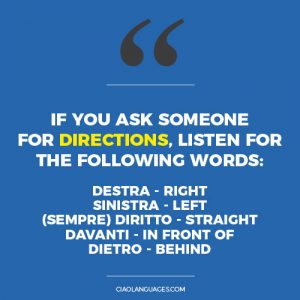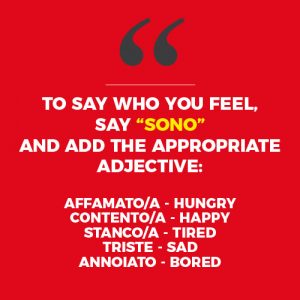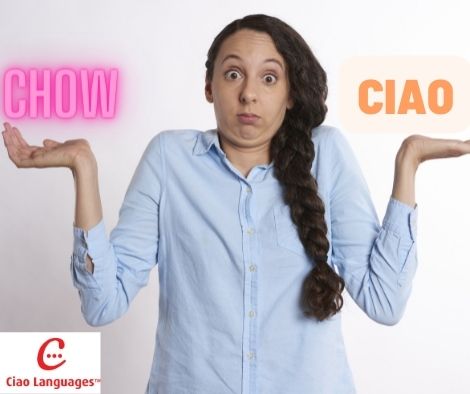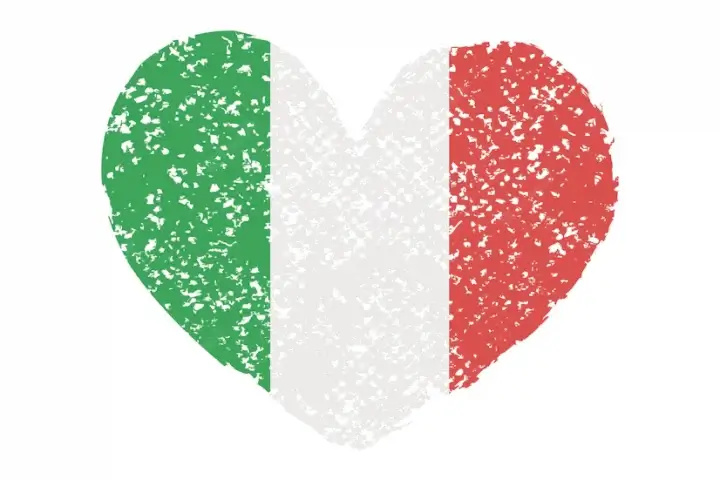Survival Italian for your trip to Italy
So, you are going to Italy and you need to know what to say when you get there!
In this article, we will give you some basic survival Italian expressions that you will need in order to get by on your journey throughout the Mediterranean boot. If you are having a hard time sounding these expressions, please check out our guide to Italian pronunciation.
In this article, we don’t just give you a list of common Italian travel expressions, but also a bit of simple grammar to help you understand the structure of the Italian language.
The really great news is that Italians are incredibly encouraging and warm people who are thrilled when foreigners attempt to speak their language. Obviously, it’s important when you are learning the italian language to speak it correctly and use proper grammar, but Italians’ willingness to overlook grammar errors is a breath of fresh air.
It’s important to emphasize here that we are simplifying things a great deal in order to give you just a few basic Italian phrases, words and structures to use on your trip to Italy. It would not be a terrible idea to consider taking a few lessons with a native speaking teacher before leaving. Ciao Languages some really good courses and if you are interested please, give us a call (949 – 478 – 1786).
“Buon giorno“: A basic greeting, only used during morning hours.
“Buona sera“: A greeting for evening hours.
“Ciao“: Means both hello and goodbye, and is considered very informal. Remember, as a beginner in Italian, you get a pass on the whole formal/informal thing. When in doubt, just use “Ciao.” With time, you will see when it is better to use “Ciao” or “Buon giorno.”
“Grazie” means “Thanks” and is pronounced with an “ay” at the end.
“Prego” means “You’re welcome” and literally means “I pray.”
“Come stai?“: “How are you?” This is informal form of the question. There is a difference between formal and informal Italian and it’s important to be mindful of it. However, if you are just learning Italian, Italians will forgive you if you just use the informal with everyone. As you improve your skills, it will be possible for you to get a better sense of when the formal register is more appropriate.

“Sto bene, grazie.“: This is easy way to say “I’m good, thanks.” If you add “E tu?”, even better because in this case you are asking the other person “And you?”
“Sono” + Adjective: “Sono” is the first person singular conjugation of the verb “essere” (to be). You can add almost any adjective after “Sono” and the sentence will make sense.
Adjectives with “o” if they refer to a man, and “a” if they refer to a woman: An adjective in Italian changes according to the gender of the speaker. The adjective “stanco” means tired, but if a woman uses it to describe her state, she will say, “Sono stanca.” (I am tired). Let’s look at some more examples:
malato/a: “Sono malato” (I’m sick if said by a man); “Sono malata” (I’m sick if said by a woman).
contento/a: “happy”; “Sono contento” (“I’m happy” said by a man), “Sono contenta“(“I’m happy” said by a woman)
triste: Sono triste” (“I’m sad” said by a man), “Sono triste“(“I’m sad” said by a woman). As you can see, in this case, the adjective does not change. That is true of adjectives that end in “e.”
“Ho” + Noun: “Ho” is the first person conjugation of the verb “avere“, “to have”. To make really simple statements about things you have, just say “Ho” and add the name of an object. “Ho soldi” means “I have money“, “Ho 10 euro,” means “I have 10 euro.”
To say your age, just say “Ho ____________ anni.” “Ho dieci anni” means “I am ten years old.”

To say you are hungry, just say “Ho fame.” It’s strange because in English we are hungry, whereas in Italian you “have hunger”. This is one of many differences between the verbs “essere” and “avere” in Italian.
“Quanto costa ……?“: If you are in a shop and you want to know how much something costs just ask “Quanto costa” + NAME OF OBJECT. For instance, if you see a bottle of wine that strikes your fancy, say “Quanto costa il vino?” Your Italian at this point is still really basic, right? Well, no problem, your goal is to get by! If you do not know the word in Italian, just point to it and say, “Quanto costa?” They’ll understand and tell you how much.
In Italian, verbs in the first person singular always end with the letter “o“. For example, if you say “Parlo inglese,” that means “I speak English” because you have added the letter “o” to the verb stem of “Parlare” (“to speak”). If you want to make a negative sentence, just add the word “non” in front of the verb. “Non parlo inglese” means “I do not speak English”.
Here are some examples of positive and negative sentences:
- parlo italiano / non parlo italiano = I speak Italian / I don’t speak Italian
- capisco / non capisco = I understand / I don’t understand
- sento / non sento = I can hear / I can’t hear
- amo / non amo = I love / I don’t love I
- odio / non odio = I hate / I don’t hate
- mi chiamo / non mi chiamo = My name is…./My name isn’t
- guido / non guido = I drive / I don’t drive
- mangio / non mangio = I eat / I don’t eat
- bevo / non bevo = I drink / I don’t drink
- vado / non vado = I go / I don’t go
- vengo / non vengo = I come / I don’t come
- parto / non parto = I leave / I don’t leave
Quick quiz! How do you say “I don’t drink wine”?
Think about it for a second before you look at the answer.
If you guessed, “Non bevo vino“, you are absolutely correct!
Bonus question, how do you say, “I don’t eat brocoli”?
“Non mangio broccoli“. Semplice, no?
Prepositions in Italian are a bit of a mess. Without getting too much into the weeds, though, let’s just go over a few of them so you can understand the general idea of how they work.
In English, when we say “To” or “At,” Italians might use “a”, “al”, “alla.”
For instance, “Vado in chiesa” means “I’m going to church.” “Vado a casa” means “I’m going home,” “Vado alla stazione dei treni” means “I’m going to the train station,” and “Sono al museo” means “I’m at the museum.” These are all variations on the preposition “a.”
Maybe you are not able to speak in complete sentences, no worries! One strategy is learn all of the questions words, “What, why, when, where, how much, etc.” Here they are!
- Dove = Where?
- Cosa = What? Also used by Italians to say “What?” (as in “What did you say?”)
- Quando = When?
- Quanto = How much?
- Perché = Why?
To ask where something is, just say “Dov’è” + NAME OF PLACE. For instance, “Dov’è il Duomo?” means “Where is the cathedral?”
If you ask for directions, you might end up listening to a long speech in Italian in which are detailed landmarks, number of meters, where not to turn and so on. Do NOT panic! Just try to listen for the following expressions:
- destra = right
- sinistra = left
- sempre diritto = straight ahead
- di fronte = across from
- davanti a = in front of
When traveling through Italy, you’ll need to know the basic names of places around town, too. Here is a list:
- centro = downtown
- albego = hotel
- aereoporto = airport
- stazione dei treni = train station
- strada = street
- via = street
- supermercato = supermarket
- parco = park
- libreria = library
- ufficio postale = post office
- duomo = main cathedral; every Italian city has one
- ristorante = restaurant
- fermata degli autobus = bus stop
- osteria = old-fashioned restaurant where clients sit together
- rositcceria = take-out food, a far sight better than American fast food!
This conludes our article about basic Italian. It’s a lot of information to digest and more importantly, to practice. If you think you would like to practice a bit before you go to Italy, contact us for live online Italian lessons with a native speaker of Italian. You’ll get a chance to take your Italian for a test run and that way be even more prepared. Remember that even just a bit of the language goes a long way to opening the way to the understanding a new culture. Your host country will be happy that you are trying to learn its language, too. Bravo!
Ciao Languages is based in Orange County, California and puts you in touch with languages from all over the world, from the convenience of your home! We are an online school, but we firmly believe in the motto “Making the Virtual Human.”
Contact Form
Contact us immediately for a quote.





